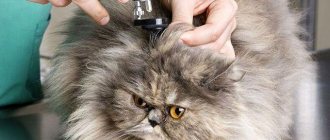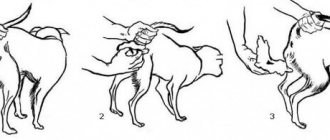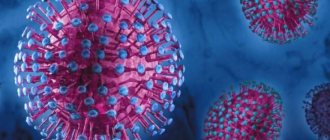A mammary tumor in a cat is a neoplasm, the appearance of which causes pathological tissue growth. It is considered one of the most common neoplasms. The formations resemble dense nodules and are localized near the nipples, armpits and groin area. The disease is difficult to treat, and the results largely depend on timely contact with a veterinarian.
Causes of tumor appearance
The exact causes of the development of mammary tumors in cats (MGT) are still unknown. But doctors identify factors that contribute to its formation.
- Age. The disease is mainly characteristic of older cats (starting from 10 years), although it occurs in young animals.
- Hormonal drugs that suppress ovarian function.
- Lack of sterilization or its implementation in adulthood.
- Heredity.
Taken together, these factors further increase the risk of developing AMD.
Cancer and mastopathy: are there any differences?
Mastitis in a cat
The insidiousness of malignant tumors is that they like to disguise themselves as harmless pathologies. So the cancer initially looks like cystic mastopathy, a benign formation of fibrous tissue. It is believed that cancer and mastopathy have the same causes: progesterone deficiency with excess estrogen.
In cats, both pathologies occur almost identically with anxiety, aggression when touching the mammary glands, and licking of the tumor. A veterinary oncologist at the RosVet VC will make an accurate diagnosis using ultrasound, CT and cytological examination.
Types and diagnosis of tumors
Mammary gland neoplasms in cats are divided into two types: malignant and benign.
In 85% of cases, malignant tissue growth is diagnosed. It may be carcinoma or sarcoma. Without treatment, death is inevitable. In the cat's mammary gland, irregular, tuberculate lumps form with numerous nodules that can bleed. This form is dangerous due to the appearance of metastases that affect other organs and tissues. Without therapy, tumors at a certain stage of development begin to deteriorate, leading to intoxication and then death.
At a certain stage, the tumor can be seen with the naked eye
Benign formations include cysts or adenomas. They are not life-threatening because they do not affect other organs. They can become large enough to prevent the cat from leading its normal lifestyle. However, an adenoma without the necessary treatment can transform and become malignant.
If you suspect AML, the cat should be shown to a veterinarian and, if possible, an oncologist. Diagnostics includes several procedures:
- first, the doctor examines, palpates the chest, abdomen, and collects anamnesis;
- then a general blood test is taken;
- tissue biopsy helps determine the type of formation;
- Ultrasound or x-rays allow you to find out what stage the disease is at and whether there are metastases.
Based on the results obtained, the veterinarian makes a diagnosis and selects treatment methods.
At the same time, it is necessary to make sure that the pet does not suffer from other diseases that have similar symptoms - mastitis, numerous insect bites.
Tumors can prevent your cat from walking
Classification of breast tumors
Determining the type of tumor is very important; the diagnostic value is to determine exactly what the veterinarian is faced with and what methods should be used to draw up a treatment plan.
Benign forms:
- adenoma, there is a uniform proliferation of glandular tissue;
- fibroma, expressed in strong compaction of connective tissue;
- lipoma, “fat knot”;
- fibrolipoma, a dense mixture of fatty and connective tissue.
The malignant neoplasms for which the prognosis is often unfavorable are:
- carcinoma, epithelial cells of the ducts or alveoli begin to divide uncontrollably and with an inflammatory process;
- mixed, the ducts and alveoli are affected together;
- Sarcoma, a very aggressive type of malignant growth, occurs suddenly (“explosion”), progresses quickly and is practically untreatable.
Main signs and stages
AMF does not have any obvious symptoms on the basis of which a non-specialist can determine the presence of this disease. Seals are detected upon contact with a pet, but only a doctor can determine the type. Therefore, at the slightest suspicion, as soon as the mammary gland begins to swell, it is necessary to take the cat to the clinic, since time is often a decisive factor in determining the effectiveness and outcome of treatment. Older animals should be examined regularly by a veterinarian.
In the initial stages, neoplasms are difficult to detect, but treatment in this case is most effective. At this stage, the disease is sometimes mistaken for a false pregnancy, when the mammary glands become enlarged and swollen.
A benign tumor can be identified by the following symptoms:
- the appearance of round, dense, nodular formations not connected to the skin;
- the tumor can become very large, there is a risk of injury;
- The cat feels fine, but has difficulty moving and may gain weight.
With the development of a malignant neoplasm, the following symptoms appear:
- formation of fixed nodules on the mammary gland and nearby lymph nodes;
- soreness when palpated;
- increased body temperature;
- loss of appetite, apathy;
- the animal constantly licks, injures the seals, wounds form in these places, from which blood and pus can be released;
- sudden weight loss.
An overgrown tumor stands out on the body, has a clear dense structure, and is often covered with ulcers.
For diagnosis, the doctor may order an x-ray
Symptomatic picture
With cancer, the appearance of lumps on a cat's chest may not be immediately detected. At the first stage, the nodules are very tiny. Their maximum size is 1-1.5 cm, and since they are hidden under the fur, the owner does not pay attention to them. The behavior of a cat in the initial stages of mammary cancer also remains normal. She eats normally and is as active as before.
© shutterstock
Alarming symptoms often appear only at the 3rd stage, when the lump reaches a size of 3-5 cm. It is characterized by the following features :
- clear boundaries;
- immobility;
- dense consistency;
- the temperature of the skin over the tumor is not increased;
- slight soreness.
With advanced mammary cancer, the lump becomes covered with ulcers that open and bleed, causing severe pain to the cat. The animal looks depressed, loses appetite and sleep, and loses a lot of weight. Lumps may appear on other parts of the body - limbs, neck, head. These are metastases.
Malignant bumps differ from benign ones, first of all, by their rapid growth. If the tumor was small a week ago, but has now reached several centimeters, the cat should be urgently shown to a doctor. The sooner treatment is started, the better.
Treatment
After the veterinarian makes a final diagnosis, he selects treatment based on age, health status, and characteristics of the tumor. The main goal of therapy is to destroy tumor cells and stop their division.
To treat a mammary tumor in a cat, your doctor may use:
- surgery;
- radiation therapy;
- cryodestruction;
- chemotherapy;
- hyperthermia;
- drug treatment, etc.
Therapy depends on the type and stage of development of AML. The doctor may use several methods simultaneously.
Surgery is one of the treatment methods for AMD
How is the operation performed?
The surgical treatment method consists of several stages.
First, the surgical field is prepared (the hair is shaved, the skin is treated with antiseptic agents). The skin is then cut so the surgeon can reach the tumor. After this, the vessels that feed the neoplasm are ligated and cut off. Then the tumor itself is removed, at the same time several centimeters of tissue that is not affected by pathological cells are excised, and the lymph nodes are removed. After this, the wound is sutured. The surgeon can remove one breast or the entire line. If the disease is advanced, complete removal of the mammary glands is possible.
This operation is considered difficult. Since the disease often returns, veterinarians never guarantee a quick recovery and full recovery even after surgery. The result primarily depends on the stage of development of the disease at which the operation was performed. The later the owner consults a doctor, the less chance not only of recovery, but also of the operation itself, since it may turn out to be useless. The only way out in this situation is to prescribe palliative treatment, which will to some extent improve the cat’s quality of life. It is treated with antibiotics, painkillers and anti-inflammatory drugs.
Sometimes surgery is not performed because the cat is too old and may not be able to withstand anesthesia.
Seeing a doctor and examination should be timely
What you need to know about the disease: stages
Neoplasms are divided into benign and malignant. If in dogs 60% of cases pass second, then in cats the picture is more depressing - only one out of 10 furry beauties who have been diagnosed with diseases of the mammary glands avoids meeting with mortal danger.
© shutterstock
Therefore, at the first suspicious symptoms, you should immediately take your cat (or cat) to the veterinarian.
- At the first stage, the cancer looks like a small lump, like a pea. At this stage, about 70% of cats can be saved because metastasis has not yet begun.
- If the hosts completely ignore the process of tumor growth, the process of tumor growth progresses rapidly, the cancer quickly invades new territories: it will simply be impossible not to notice large mammary glands. The result will soon be a breakthrough of the neoplasm, then an open ulcer will form. If the disease is caught at this second stage, then veterinarians perform surgery, combining it with chemotherapy. The chances of survival for such cats are 50%.
- When time is lost, the third stage begins - unchecked malignant cells attack other organs, the lymphatic system, the brain and bone marrow. At this stage, we are no longer talking about improving the patient’s life; all efforts are directed toward combating multiple metastases.
- The fourth stage is the last, cure is impossible. The tumor is large. Metastases have spread throughout the body, the lymph nodes are enlarged. The cat is extremely weak, there is complete exhaustion. To alleviate the condition, potent drugs are used. The disease progresses, the extreme severity of the patient’s condition sometimes forces doctors to resort to euthanasia, because the cancer will no longer give up its position.
Drug treatment
The use of drugs to treat AMD is possible either in the initial stages of the disease (instead of surgical treatment) or after surgery. In this case, medications should prevent relapse and the appearance of metastases. For drug treatment, Doxorubicin, Taxotere, and Cyclophosphamide are used.
Antitumor drugs are not prescribed if the disease has progressed to the fourth stage. In this case, with the massive decay of pathological cells that have affected other tissues and organs, intoxication and necrosis may begin, which will negatively affect the cat’s well-being.
Hormonal therapy for AMD is ineffective, so in some cases it is used only as an adjuvant.
If the tumor is opened and purulent or bloody discharge appears, if for some reason it is impossible to perform surgery, only conservative treatment remains. The wound is treated with ointments that stop purulent-necrotic processes (this can be Levomekol). An antibiotic must be prescribed (for example, Tsiprovet, Fosprenil). To alleviate the condition, painkillers are prescribed.
The doctor may also prescribe medication
Stages of development of breast tumors
Any cancerous tumor goes through several stages of its growth:
- The tumor is less than 10 mm in size, metastases are not detected.
- The tumor reaches 30 mm, but there are no metastases.
- The tumor is over 50 mm in diameter, ulcers may appear, and metastases are diagnosed in the lymph nodes.
- Metastases are found in the lungs, liver and other organs and tissues.
Caring for your pet after surgery
As a rule, after surgery to remove a tumor, cats are discharged home on the second to fifth day, based on the general condition of the animal. 12-16 days after surgery, the cat must be examined by an oncologist. Then the doctor removes the stitches.
The rehabilitation period lasts from ten days to two weeks. During this time, the pet must wear a veterinary cone or blanket, its mobility must be limited, and proper nutrition must be ensured. The owner should regularly clean the sutures in accordance with the recommendations received from the doctor.
If the tumor was malignant, it is necessary to visit a veterinarian quarterly.
After surgery, you need to carefully monitor your cat's condition.
Chemotherapy
This stage of therapy is designed to completely stop the development of the pathological process, therefore the use of strong drugs is justified. The result is serious intoxication of the animal, whose condition during this period of time must be monitored especially carefully, because chemotherapy against cancer for humans is a cruel procedure.
Sometimes chemotherapy is the only way to salvation, because not all older cats can boast of ideal health. This treatment option is also available in other cases: if the tumor is quite small, it is possible to do without a surgeon.
Forecast
If any lumps are found in the animal, it is necessary to consult a veterinarian as soon as possible, who will conduct all the necessary tests and make a diagnosis. Life expectancy in this case will depend on how quickly the diagnosis was made and appropriate treatment started. Age, general health, and tumor type also affect the results.
According to doctors, a lot depends on the size of the tumor: with a small tumor (up to two centimeters), a cat can live for about three years. If the tumor is more than three centimeters, this period is reduced to six months. If the tumor was discovered too late and metastases affected other organs, it is believed that the animal will not live more than six months.
By using antitumor drugs, you can extend your cat's life by another six months. After surgery to remove the milk, the animal can often live for about another year. The use of therapy in the final stages of cancer can only reduce suffering without significantly affecting life expectancy.
A sick animal needs human support
Diagnosis of cancer
Detection of even a millimeter thickening should be a reason to contact a specialized clinic. The veterinarian will perform a complete physical examination, paying most attention to the area with growths. The doctor will definitely palpate the lymph nodes: their enlargement may indicate that the process of metastasis has begun.
But to make a final diagnosis, determine the stage and type of the disease, a fine-needle biopsy, cytological examination and a comprehensive blood test (which will allow you to assess the general health of the sick animal) are required. Additional diagnostic tests may include urinalysis and blood clotting time.
Next, you will be given a referral for a computed tomography scan. Only a three-dimensional image will allow you to determine the size, exact localization of the tumor and the presence of metastases. If the process of metastasis is confirmed, then an additional ultrasound examination of the abdominal cavity is performed to detect the affected organs.
Preventive measures
It is impossible to completely prevent the appearance of tumors. But despite this, it is necessary, if possible, to eliminate risk factors that contribute to the proliferation of cancer cells.
First of all, you need to monitor your diet: the diet must be balanced, and the products must not contain carcinogenic substances. It is necessary to monitor the animal’s weight and maintain an active lifestyle. The owner must exclude hormonal drugs that suppress sexual instincts (the cat must be sterilized or regularly bear offspring).
You should not ignore preventive examinations, thanks to which you can timely identify the disease at the initial stage.
Upon reaching a critical age (7-10 years), the owner must independently examine and palpate the animal, checking whether a lump has appeared on the cat’s mammary glands.
Why does breast cancer occur in cats?
Cancer is a common pathology and ranks 4th among all diseases leading to death in cats. The top ten most common types of cancer pathologies include tumors in the mammary glands. Only in 14% of cases are benign growths diagnosed; mostly malignant tumors are detected, which are characterized by an aggressive course, an increased risk of metastasis and a poor prognosis for survival.
Mammary cancer is most common in cats over 10 years of age
Breast cancer occurs mainly due to hormonal imbalances. At risk are nulliparous elderly females during menopause (after 7–10 years). A direct relationship has been proven between the development of cancer and the treatment of animals with hormonal drugs. For example, drugs to suppress the sexual instinct (Antisex, Kovanin, Gestrenol, Stop-Intim, etc.) double the risk of developing tumors. It is much safer to sterilize the animal before the onset of the first heat.
Hormonal drugs for regulating sexual desire are dangerous due to an increased risk of developing malignant tumors
External factors play a role in the development of cancer - lifestyle and environmental conditions. The likelihood of cancer increases with:
- poor nutrition;
- constant stress of the animal;
- influence of radiation.
Predisposing diseases against which tumors often form are:
- atypical hyperplasia of the mammary glands;
- endocrine and metabolic disorders: obesity;
- atherosclerosis;
- diseases of the adrenal glands and thyroid gland.
A genetic predisposition to breast tumors has been identified. Siamese and Oriental cats are most prone to mammary cancer. The culprit is a mutation in the BRCA-1 and BRCA-2 genes. The presence of cancer in a family history is also an alarming sign (breast tumors are often detected in cats whose mothers or grandmothers had cancer of the mammary gland, ovaries, or intestines).
Due to a genetic mutation, Siamese and Oriental cats are most susceptible to breast cancer
Establishing diagnosis
It is important to detect breast cancer in its infancy, so early diagnosis of the disease should be taken very seriously. The owner should take the animal to a good veterinarian in a timely manner. A professional is able to conduct high-quality diagnostics. In addition, the clinic must have all types of special equipment available to assist the doctor, allowing him to perform instrumental examinations. These include:
- Ultrasound;
- performing radiography;
- conducting magnetic resonance and computed tomography.
A cat's tooth fell out: main symptoms and treatment options
Establishing an accurate diagnosis can determine further actions: whether to perform a biopsy or limit yourself to fine needle aspiration - a method of penetrating the affected area. In this case, a cytological examination is performed.
Important! The correct diagnosis depends on careful collection of biopsy material. It all depends on the professional level of the veterinarian. Accidental injury to a tumor site will ultimately lead to a rapid process of increasing the number of metastases. The disease will take on severe forms.
It is necessary to conduct studies of the inguinal and axillary lymph nodes. Areas that the disease affects more often.
Diagnosis
Extensive information will be provided by performing a detailed blood test. Based on its results, the degree of the inflammatory process will be indicated. In addition, concomitant infections will be identified, which must always be taken into account in order to correctly structure the treatment procedure.











